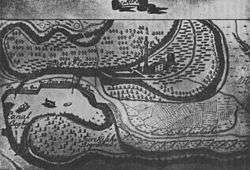Nova Barcelona
Nova Barcelona, is the name of a short-lived colony of Catalan exiled Austracists existing from 1735 to 1738 that was created after the defeat of the supporters of Habsburg Spain. This colony was located in The Banat of Temeswar, on the site of the present town of Zrenjanin in Serbian Vojvodina. The colony was also known under the name Carlobagen, not to be confused with Karlobag in Croatia.
History
In October 1716, following the Battle of Petrovaradin, a decisive Austrian victory in the Austro-Turkish War of 1716–18, the Habsburgs conquered the Ottoman town (Veliki) Bečkerek / (Nagy) Becskerek, now Zrenjanin in Vojvodina. With the Treaty of Passarowitz from July 21, 1718, the Ottoman Empire had to cede the Banat of Temeswar to the Austrian archduke. In order to develop the newly acquired region an Imperial Privileged Oriental Company (Kaiserliche privilegierte orientalische Kompagnie) was founded in 1719. It was intended to foster the commerce with the Ottoman Empire through the Danubian basin and the Adriatic ports of Trieste and Fiume. The Banat was underpopulated and the imperial authorities boosted its colonization with new settlers.
Austracists's second exile
In 1735, Naples and Sicily were attacked by King Philip V of Spain. For many Catalans who there resided seeking refuge after the War of Spanish Succession, then began a second exile, this time in Vienna. Perceived by the public as an economic burden to the treasury of the Holy Roman Empire, Charles VI tried to convert the Austracist refugees into settlers by installing them in a region bounded by the Danube River, the natural border of the empire. The settlement was to be named Nova Barcelona(New Barcelona) but also Carlobagen, Carolonoble, or Carolina seem to have been proposed.
Arrival of settlers
The first group of exiles arrived in the autumn of 1735, and in 1737 there were about 800 exiles in Banat, out of some 3.500 – 5.000 present at the time in Hungary.[1] Among them, the most numerous were those from Catalonia, followed by others from the former territories of the Crown of Aragon. Between 10% and 15% came from Sicily and Naples. Among the exiles were major figures in the War of the Spanish Succession like the brothers Rafael and Joan Nebot (General and Colonel, respectively), Captain Francesc de Castellví i Obando and probably Colonel Pere Joan Barceló i Anguera (alias Carrasquet or Carrascot, currently rendered Carrasclet).
Failure
The installation was a failure partly because of the advanced age of settlers, most of them being veterans of the administration and the army. The continental climate of Banat affected the economic viability of the project to build a city. The plague that raged in Vojvodina in 1738 and the proximity of the region to the Ottoman threat were other factors that precipitated the end of the colony. The year 1740 marked an important milestone for the exiles, with the death of Emperor Charles VI, October 20. His successor, Maria Theresa of Austria, was not bound by oath to the Austracist refugees. By 1740, many exiles had already moved to the cities of Austria-Hungary, especially Budapest and Vienna.
Legacy
The colony of Austracist exiles has left almost no trace in the region except for Francesc de Vilana Perlas i Fàbrega —the son of the émigré and Marquis of Rialb Ramon de Vilana-Perles i Camarasa—, who was governor of Timişoara between 1753 and 1759. According to Collin Thomas, his name would be at the origin of the name of Perlez, a village in the municipality of Zrenjanin.
References
- ↑ Alcoberro, Agustí (2002). L’exili austriacista i la Nova Barcelona del Banat de Temesvar: teoria i pràctica. Boletín de la Real Academia de Buenas Letras de Barcelona, Nº. 48. pp. 104–107. ISSN 0210-7481. Retrieved August 26, 2012.
Bibliography
- Agustí Alcoberro. L’exili austriacista i la Nova Barcelona del Banat de Temesvar: teoria i pràctica, Boletín de la Real Academia de Buenas Letras de Barcelona, ISSN 0210-7481, Nº. 48, 2002, pages. 93-112 (Catalan)
- Agustí Alcoberro. Sàpiens (Descobreix la teva història) No 67: La nova Barcelona: La ciutat dels exiliats del 1714, Sàpiens Publicacions, Revue, Barcelone, mai 2008 (Catalan)
- Una bandera turca arraso la Barcelona del Danubio, La Vanguardia, Revue, 18 octobre 1992, page 3 (Spanish)
- Ernest Lluch, L'alternativa catalana, 1700-1714-1740: Ramon de Vilana Perlas i Juan Amor de Soria : teoria i acció austriacistes, Eumo, 2002 (Catalan)
- Agusti Alcoberro, L'Exili austriacista (1713-1747), Volum 1, Fundacio Noguera, Textos i Documents 35 (Catalan)
- Ivan Kukuljević Sakcinski, Nadpisi sredovječni i novojeki na crkvah: javnih i privatnih sgradah i.t.d. u Hrvatskoj i Slavonij, Knjižara Jugosl.akad., 1891 (Croatian)
